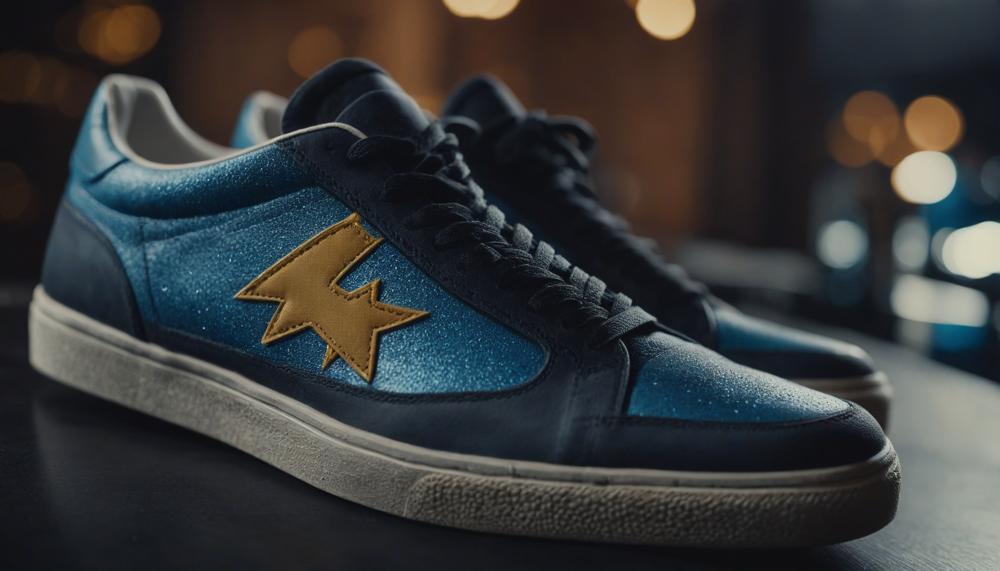Yes, you can prevent acrylic paint from cracking on shoes. Acrylic paint is versatile and vibrant but can be prone to cracking if not applied correctly. The good news is, with the right techniques and products, you can maintain the paint’s integrity and ensure your custom shoe designs look fresh and last longer.
Here’s what you need to know to keep your painted shoes in top condition:
- Use a Sealant: Apply an acrylic paint sealant specifically designed for flexibility to help the paint move with your shoes without cracking.
- Thin Layers: Paint in thin layers, allowing each layer to dry completely before adding another. This reduces the risk of cracking and helps the paint adhere better.
- Mind the Flex Zones: Pay special attention to areas that bend a lot, like the toe box. Adjust your painting technique to go with the shoe’s natural flexing.
- Waterproofing: After sealing the paint, apply a waterproof spray. This extra step shields the paint from water and moisture, which can cause damage over time.
- Brand Consistency: Stick to one brand of paint for the entire project to avoid inconsistencies in texture and drying time, which can lead to cracking.
- Durability Awareness: Remember, even with the best application, acrylic paint on shoes can fade over time due to wear and exposure to elements.
Engaging with these strategies not only enhances the durability of your painted shoes but also ensures the vibrancy of your designs.
Let’s dive into how you can apply these techniques for the best results and explore some creative ideas for your next shoe painting project.
About Acrylic Paint
Contents
| Type of Paint | Base | Main Features |
| Acrylic Paint | Water-based with acrylic polymer | Fast-drying, versatile, water-resistant when dry, suitable for various surfaces |
| Latex Paint | Water-based | Used mainly for walls, non-toxic, cleans up with water |
| Oil Paint | Oil-based | Slow drying, excellent color richness, used for art and furniture |
Acrylic paint is a vibrant and versatile type of paint that incorporates acrylic polymer emulsion, distinguishing it from other paints primarily by its formulation and properties. Unlike oil-based paints, which are renowned for their smooth application and rich color depth, acrylics are water-based, making them easier to clean up and less toxic. They dry quickly to a flexible, water-resistant finish, which is ideal for various art projects, including shoe customization.
The drying characteristic of acrylic allows for rapid layer application without the lengthy waiting times associated with oil paints. Additionally, when it comes to altering your kicks, acrylic paint, because of its polymer base, adheres well to surfaces and, once sealed, can resist weathering and wear—attributes not typically found in other water-based paints like latex.
It’s important to use a sealant with acrylic paint, especially on flexible surfaces like shoes, to avoid cracking. Applying the paint in thin layers will follow the natural flexing of the shoe, minimizing any potential damage or wear over time. Moreover, protecting the paint job with a waterproof spray ensures longevity and vibrant color retention.
What Sort Of Paint To Work With On The Shoes?
To avoid cracking on painted shoes, your go-to choice should be acrylic paint. Acrylics are renowned for their flexibility and durability, particularly when applied to materials that bend and stretch, like shoes. Below, I’ve detailed why acrylic paints excel in this regard and how to apply them effectively to ensure your designs remain pristine.
Key Points on Using Acrylic Paint on Shoes:
- Flexibility: Acrylic paint adapts well to the flexing motion of shoes, reducing the risk of cracking if applied correctly.
- Durability: With proper application and sealing, acrylic paint can withstand wear and tear without flaking or peeling.
- Variety: Available in an array of vibrant colors, acrylic paints offer limitless creative possibilities for custom shoe designs.
To maximize the benefits of using acrylic paints on shoes and minimize the risk of cracking, follow these steps:
- Preparation: Ensure the shoe surface is clean and free from any oils or dust.
- Application: Paint in the direction that the shoe flexes. Use multiple thin coats rather than a single thick coat, allowing each layer to dry thoroughly before applying the next.
- Sealing: After the paint has dried, apply an acrylic sealant in short bursts to protect the paint. This helps lock in the color and further prevents cracking.
Additionally, treating the shoes with a waterproof spray post-painting will safeguard your artwork against moisture and dirt, preserving the vibrancy and integrity of the design.
Table of Recommended Acrylic Paint Brands and Products for Shoe Customization:
| Brand | Product | Features |
| Angelus | Angelus Leather Paint | Specifically formulated for leather, high flexibility, excellent coverage |
| Golden | Golden High Flow Acrylics | Superb fluidity for detailed work, highly pigmented, versatile usage |
| Liquitex | Liquitex Professional Acrylics | High viscosity, long-lasting finish, suitable for various materials |
How To Stop Acrylic Paint From Cracking On Shoes?
To effectively prevent acrylic paint from cracking on shoes, follow these practical and simple steps.
Each method has been selected for its direct impact on enhancing the durability of your artwork on shoes, ensuring both flexibility and longevity.
Choose the Right Type of Acrylic Paint
Opt for paints specifically designed for use on shoes, which often come in two grades – regular and professional. Professional grades are generally more flexible and resistant to cracking.
Apply Acrylic Paint Sealant
After painting, protect your design by using an acrylic paint sealant. This adds a protective layer that minimizes cracking as the shoe flexes during wear. Apply it in quick, even bursts to cover all painted areas effectively.
Paint Application Technique
When applying paint, consider the shoe’s flex points, such as the toe box. Paint in the direction that the shoe flexes to allow the paint to move with the shoe rather than against it, reducing the risk of cracking.
Layering and Drying
Use several thin layers of paint rather than one thick layer. Allow each layer to fully dry in a well-ventilated area before applying the next. This technique prevents thick layers from cracking and peeling.
Finish with Waterproofing
After the sealant, apply a waterproof spray to further protect the paint from weather elements like rain, which can cause the acrylic to lift and crack.
Consistency in Products
Stick to one brand of paint and sealant for consistent results.
Different brands may have slightly different formulations that could react with one another, potentially leading to cracking.
How To Paint Leather Shoes?
Properly painting leather shoes to ensure the acrylic paint does not crack involves meticulous preparation and application. Here’s a streamlined guide:
Choosing the Right Paint:
Ensure you select acrylic paint specifically designed for leather applications.
This specificity ensures better adhesion and flexibility.
Preparation of the Shoes:
Start by cleaning the shoes thoroughly with a leather preparer and deglazer.
This step removes any factory finish and contaminants that could prevent the paint from adhering properly.
Application of Paint:
| Step | Action | Tip |
| First Layer | Apply a thin layer of paint using a soft brush. | Let it dry completely before adding another layer. |
| Subsequent Layers | Continue with thin layers, allowing drying time in between. | Paint in the direction the shoe flexes. |
Sealing the Paint:
Use an acrylic sealant to protect the paint. Apply in quick bursts to avoid heavy application, which can cause the paint to run or smudge.
Drying Time:
Allow the sealant to dry thoroughly. This step is crucial as it locks in the paint and prevents cracking.
Waterproofing:

Once the sealant is dry, treat the shoes with a waterproof spray. This not only adds an extra layer of protection against water but also against quick wear and tear.
Final Checks:
Inspect the shoes for any missed spots or potential cracks in the paint. If needed, apply corrective thin layers of paint or sealant.
How To Paint Running Shoes?
To properly paint running shoes with acrylic paint and prevent cracking, it’s crucial to follow these detailed steps. Ensuring you prepare adequately and apply the paint correctly will enhance the durability and appearance of your shoes.
| Step | Action | Details |
| Preparation | Clean and Dry | Thoroughly clean the shoes to remove dirt and oils. Let them dry completely before painting. |
| Base Coat | Apply White Base Layer | Use a white acrylic paint as a base to ensure colors pop. Apply evenly and allow it to dry fully. |
| Painting | Apply Thin Layers | Paint using multiple thin layers, letting each layer dry before applying the next. This prevents cracking. |
| Detailing | Brush Selection | Use a small brush for detailed areas and a larger brush for broad surfaces to maintain consistency. |
| Sealing | Apply Sealant | After the final paint layer, apply an acrylic sealant to protect the paint from peeling and cracking. |
| Waterproofing | Waterproof Spray | Once the sealant dries, spray a waterproofing layer to guard against moisture and wear. |
Here are additional tips to ensure your painted shoes remain vibrant and crack-free:
- Flex Points: Pay attention to flex areas like the toe box. Apply paint in the direction of the shoe’s flex to accommodate bending.
- Consistency: Stick to one paint brand to avoid variations in texture and drying time.
- Ventilation: Always work in a well-ventilated area to avoid inhaling fumes from the paint and sealant.
By following these steps, you’ll achieve a professional finish on your running shoes that not only looks great but also stands up to regular use.
How To Stop Cracking On Shoes After Painting?
To prevent acrylic paint from cracking on shoes after painting, it’s essential to follow specific preparation and application techniques. Here’s a step-by-step guide to ensure durability and flexibility of your painted shoes:
Surface Preparation
- Clean the shoes thoroughly to remove any dirt, grease, or existing coatings that might prevent paint adhesion.
- Lightly sand the surface if the shoe is particularly glossy to provide a better grip for the paint.
Paint Application
- Apply the paint in thin, even layers. Thick layers are prone to cracking as they may not dry evenly.
- Allow each layer to dry completely before applying the next. This prevents the paint from becoming too thick and losing its flexibility.
Environmental Considerations
- Paint in a controlled environment where temperature and humidity are stable. Extreme conditions can affect how the paint dries and adheres to the shoe surface.
Sealing and Protection
- Once the final paint layer is dry, apply an acrylic sealant to protect the paint. This layer helps to lock in the color and reduce the risk of cracking.
- For added protection, especially for shoes that will be worn outside, apply a waterproof spray that provides a barrier against moisture and dirt.
Things To Keep In Mind
When aiming to prevent acrylic paint from cracking on shoes, several key factors need consideration to ensure longevity and durability of your artwork. Here’s a breakdown of what to watch out for:
- Environmental Impact: Temperature and humidity play significant roles. High fluctuations can cause the paint to expand and contract, leading to cracks.
- Application Techniques: Ensure even application without over-thinning the paint. Thin layers might seem economical but can weaken the paint’s structure.
- Layering and Drying: Avoid heavy layers without sufficient drying time in between. This can trap moisture and promote cracking as the paint dries.
- Surface Preparation: Shoes should be clean, dry, and free from any oils or dirt. Priming the surface can significantly enhance paint adhesion and flexibility.
- Paint Quality and Flexibility: Acrylic paint varies in quality. Higher-grade paints with good flexibility are less likely to crack after drying.
- Mixing Mediums: Be cautious with mediums. Some can enhance flexibility, while others might weaken the paint if used excessively.
Conclusion
Protecting your painted shoes from the perils of cracking can transform your favorite pair from mere footwear into a walking canvas of lasting art. The key is meticulous application and strategic protection. Begin by selecting acrylic paint designed specifically for the dynamic environment of footwear. This ensures both flexibility and compatibility with the material of your shoes. During application, embrace the art of patience: paint in deliberate, thin layers and allow each to thoroughly dry. This not only fortifies the bond to the shoe but also precludes the menace of peeling layers.
Accentuating the paint’s durability involves safeguarding it against the elements. Here, a dual approach proves most effective. First, a dedicated sealant for acrylic paint acts as an armor, flexing with your shoes and preventing cracks. Follow this with a waterproof spray, which serves as a shield against moisture—ensuring that each step you take preserves the vibrancy and brilliance of your design.
Finally, consistency is your ally in this creative endeavor. Stick to a single brand of paint and sealant to avoid adverse reactions between products. This coherent strategy not only optimizes the appearance but also maximizes the lifespan of your artwork.






